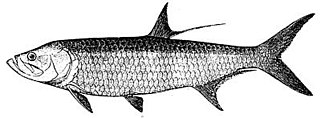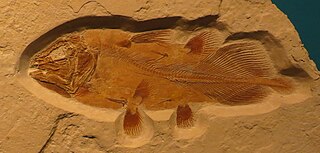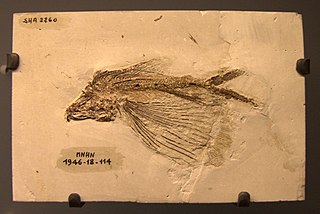
The Elopiformes are the order of ray-finned fish including the tarpons, tenpounders, and ladyfish, as well as a number of extinct types. They have a long fossil record, easily distinguished from other fishes by the presence of an additional set of bones in the throat.

The beardfishes consist of a single extant genus, Polymixia, of deep-sea marine ray-finned fish named for their pair of long hyoid barbels. They are classified in their own order Polymixiiformes. But as Nelson says, "few groups have been shifted back and forth as frequently as this one, and they were recently added to Paracanthoptergii". For instance, they have previously been classified as belonging to the Beryciformes, and are presently considered either paracanthopterygians or the sister group to acanthopterygians. They are of little economic importance.

Xiphactinus is an extinct genus of large predatory marine ray-finned fish that lived during the late Albian to the late Maastrichtian. The genus grew up to 5–6 metres (16–20 ft) in length, and superficially resembled a gargantuan, fanged tarpon. It is a member of the extinct order Ichthyodectiformes, which represent close relatives of modern teleosts.

Berycopsis is an extinct genus of marine ray-finned fish from the Late Cretaceous period. Fossils are known from England, Germany, and Lebanon. A potential specimen is known from the Czech Republic.

Protosphyraena is a fossil genus of swordfish-like marine fish, that thrived worldwide during the Cretaceous period (Albian-Maastrichtian). Fossil remains of this taxon are mainly discovered in North America and Europe, and potential specimens are also known from Asia, Africa and Australia. Its fossils are best known from the Smoky Hill Member of the Niobrara Chalk Formation of Kansas.

Dercetis is a genus of prehistoric marine ray-finned fish. It is the type genus of the family Dercetidae, a group of slender, elongate aulopiforms, which were related to modern lizardfish and grinners. It is known from the Late Cretaceous of Europe, the Middle East, and western North America.

Exocoetoides is an extinct genus of prehistoric ray-finned fish.
Acrogaster is a genus of fossil marine fish in the order Trachichthyiformes, known from the Late Cretaceous period. Species are known from Germany and Lebanon.

Libys is a genus of coelacanth fish in the family of Latimeriidae. Species of Libys lived during the Upper Jurassic period.
Ctenocephalichthys is an extinct genus of prehistoric marine ray-finned fish, generally considered a holocentriform, that lived during the Late Cretaceous. It is known from Cenomanian to the Santonian of Lebanon.
Dinopteryx is an extinct genus of prehistoric beardfish from the Late Cretaceous period. It contains a single species, D. spinosus, known from the Santonian of Lebanon. It is the only member of the extinct family Dinopterygidae, which is considered a distinct family of the Polymixiiformes. It was previously placed in the genus Hoplopteryx.
Telepholis is an extinct genus of prehistoric bony fish that lived from the Cenomanian to Campanian.
Charitosomus is an extinct genus of prehistoric marine ray-finned fish from the Late Cretaceous, related to modern beaked salmons. They were nektonic carnivores in life.

Davichthys is an extinct genus of prehistoric marine ray-finned fish related to modern ladyfish. It is known from the Late Cretaceous of southern Europe, the Middle East, and North Africa. It is one of the earliest known elopids.

Cylindracanthus is an extinct, enigmatic genus of marine ray-finned fish with fossils known throughout North America, Europe, Asia and Africa from the Late Cretaceous to the late Eocene, with potential Oligocene records and a possible Miocene record also known. It is exclusively known from its distinctive partial remains, which are long cylindrical bony spines that are usually considered rostrum fragments, as well as some associated teeth. These spines are abundant & widespread throughout this timespan, and are useful indicators of a nearshore marine environment, but the taxonomic identity of the fish is still highly uncertain and debated.

The paleontological sites of Lebanon contain deposits of well preserved fossils and include some species found nowhere else. Notable among these is the Lebanese lagerstätten of the Late Cretaceous age, which contain a well-preserved variety of different fossils. Some fossils date back to the Jurassic period, and younger fossils of mammals from a different site belong to the Miocene through the Pleistocene.

Dorateuthis is a genus of cephalopod with a gladius and soft-part anatomy preserved. Fossils of D. syriaca are found in Upper Santonian-aged shale of Late Cretaceous Lebanon.

Cheirothricidae is a family of extinct marine ray-finned fish, perhaps belonging to the Aulopiformes, although they are tentatively placed as indeterminate eurypterygians. They lived during the Upper Cretaceous and their fossil remains are found in the Middle East and Europe. They were characterized by very expanded even fins.

James William Davis was a British naturalist who specialised in fossil fish. He lived at Chevinedge, Halifax in Yorkshire. James William Davis was a leading member of the Yorkshire Naturalists' Union and a Fellow of the Geological Society of London.
Sahel Alma or Sahel Aalma is a Late Cretaceous paleontological site and Konservat-Lagerstätte in Keserwan-Jbeil, Lebanon. Located near the town of the same name, it documents well-preserved deepwater marine fossils dating to the late Santonian stage of the Cretaceous. It is often associated with the slightly older, similarly famous Sannine Formation sites, with these four sites being together referred to as the "Fish Beds" of Lebanon.














